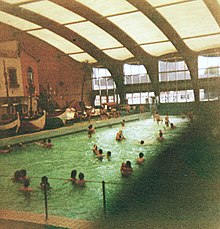Kaiserstuhl colliery
| Kaiserstuhl colliery | |||
|---|---|---|---|
| General information about the mine | |||
|
Remaining daytime facilities of the Kaiserstuhl colliery as of October 2004 |
|||
| other names | Westphalia colliery | ||
| Mining technology | Civil engineering | ||
| Funding / year | 838,936.25 t | ||
| Funding / total | 6711 490 t hard coal | ||
| Information about the mining company | |||
| Operating company | Hoesch Bergwerks AG | ||
| Employees | 6687 (1953) | ||
| Start of operation | 1853 | ||
| End of operation | 1966 | ||
| Successor use | Fun pool, mall | ||
| Funded raw materials | |||
| Degradation of | Hard coal | ||
| Geographical location | |||
| Coordinates | 51 ° 31 '48 " N , 7 ° 28' 16.5" E | ||
|
|||
| Location | Glückaufstrasse, north of the city center | ||
| local community | Dortmund | ||
| Independent city ( NUTS3 ) | Dortmund | ||
| country | State of North Rhine-Westphalia | ||
| Country | Germany | ||
| District | Ruhr area | ||
The Zeche Kaiserstuhl was a coal - mine in Dortmund .
history
The history of the Kaiserstuhl colliery began in 1853 with the sinking of shaft 1 under the name of Zeche Westphalia , because the colliery was originally owned by the United Westphalia mining union and only later, in 1899, became the core of the mine property of Eisen- und Stahlwerk Hoesch AG .
In 1952 the mines Kaiserstuhl 1 and Kaiserstuhl 2 as well as the composite mine Zeche Fürst Leopold / Zeche Baldur in Dorsten were spun off from the Hoesch AG and merged into the "Hoesch Bergwerks AG". 1953 were mines Kaiserstuhl 1 and Kaiserstuhl 2 connected on the 7th floor and 1,955 on Kaiserstuhl-East, a new headframe with vascular promotion erected. With this, the entire production of both mines was brought to light and processed on the Kaiserstuhl 2 facility .
In the course of the coal crisis that began in 1957, the Kaiserstuhl colliery was partially closed in 1959/1960. The final shutdown took place despite above-average shift work on June 30, 1966. 1969-70 the buildings and shafts of Kaiserstuhl 1 (West) were demolished to make room for the first WEZ and Tropamare.
All three shafts of the Kaiserstuhl 2 colliery (east) were permanently filled in the summer of 2004 , provided with protective hoods and fenced off. At the same time, the last remnants of the lawn hanging bench and the carriage circulation were removed. Until then, the shafts were only loosely filled and covered with sheet piles.
Coking plant
At the Kaiserstuhl colliery, Franz Brunck (1837–1895) built the world's first large-scale benzene production plant from coke oven gas, which later became the Kaiserstuhl coking plant and Hoesch-Petrol GmbH.
Accidents
The Kaiserstuhl colliery has been repeatedly hit by mining accidents . The worst of these was the firedamp explosion on Shaft I on August 19, 1893; 62 miners died . On December 22, 1897 another firedamp explosion occurred on Kaiserstuhl II; this time 20 miners died. The next firedamp explosion with 8 fatalities occurred on February 20, 1917, and on August 8, 1920, 31 miners were killed in a cable accident. When coal fell on Kaiserstuhl II, 3 miners died on August 6, 1932 and on January 16, 1942, 42 people died in a mine fire on Kaiserstuhl I. A tomb is located at the Ostenfriedhof Dortmund , where 48 of the victims were buried.
Reuse
The concrete headframe on Kaiserstuhl 2 (east), with which one of the shafts was built over, was demolished in the mid-1990s along with other daytime facilities of the mine and large parts of the so-called "old hut", where a hot-dip coating plant now stands. The remaining remnants of the daytime facilities, including black paws , brand control , wages hall and administration, were demolished in May 2006. B. the black chow on May 17th.
From 1973 to around 1984, the Tropa Mare leisure pool was located on the site of the Kaiserstuhl 1 berth, which was closed after a chlorine release. The Westfalen shopping center (WEZ) was located here until 2008. It has now been canceled and a new WEZ was opened at the same location in 2009.
literature
- Wilhelm Hermann, Gertrude Hermann: The old mines on the Ruhr. Past and future of a key technology. With a catalog of the "life stories" of 477 mines. 6th edition, expanded to include a digression according to p. 216 and updated in parts relating to energy policy. The 5th, completely revised and expanded edition 2003, updated by Christiane Syré and Hans-Curt Köster. Langewiesche Köster, Königstein im Taunus 2008, ISBN 978-3-7845-6994-9 .
Web links
- Timeline of the Kaiserstuhl colliery. Retrieved April 18, 2010 .
- 360 ° panorama picture of the tomb for the miners of the Kaiserstuhl colliery in the Westphalian Cultural Atlas (requires Flash player )
- http://ruhrzechenaus.de/dortmund/do-kaiserstuhl.html
Individual evidence
- ↑ Otto Grosskinsky (ed.): Handbuch des Kokereiwesens , Vol. 2. Knapp, Düsseldorf 1958, p. 139.


